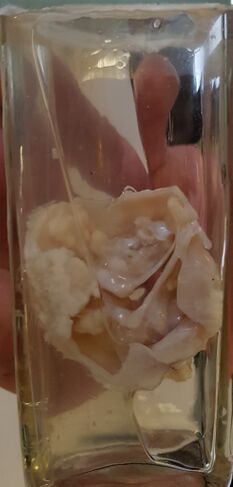15. Nodular calcified aortic stenosis: Difference between revisions
No edit summary |
No edit summary |
||
| Line 15: | Line 15: | ||
'''Theory''': | '''Theory''': | ||
Aortic stenosis is a type of dystrophic calcification. | Aortic stenosis is a type of dystrophic calcification. The aortic valve is normally tricuspid, however a condition called ''congenital bicuspid aortic valve'' exists. This bicuspid aortic valve is very predisposed to calcification early in life. The calcification can cause stenosis, which can lead to left ventricular failure. The only treatment is replacement of the valve.[[File:Calcified aortic stenosis prep.jpg|center|thumb|Physics-defying fluid level|487x487px]] | ||
The aortic valve is normally tricuspid, however a condition called ''congenital bicuspid aortic valve'' exists. This bicuspid aortic valve is very predisposed to calcification early in life. The calcification can cause stenosis, which can lead to left ventricular failure. The only treatment is replacement of the valve. | |||
[[File:Calcified aortic stenosis prep.jpg|center|thumb|Physics-defying fluid level| | |||
[[Category:Pathology 1 - Macropreparations]] | [[Category:Pathology 1 - Macropreparations]] | ||
Latest revision as of 16:55, 27 June 2024
Organ: Aortic valve
Description:
The superior aspect of the preparation is the aortic surface of the valve. The inferior aspect is the ventricular surface.
On the inferior surface the valve has an abnormally small diameter, and small, nodular calcified foci can be seen.
Diagnosis: Nodular calcified aortic stenosis
Causes:
- Not significant
Theory:
Aortic stenosis is a type of dystrophic calcification. The aortic valve is normally tricuspid, however a condition called congenital bicuspid aortic valve exists. This bicuspid aortic valve is very predisposed to calcification early in life. The calcification can cause stenosis, which can lead to left ventricular failure. The only treatment is replacement of the valve.

